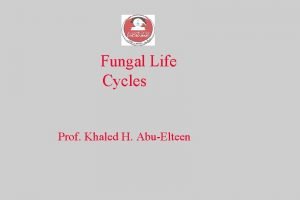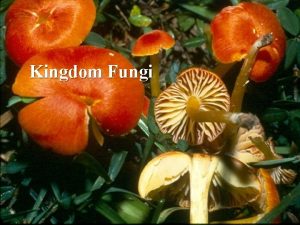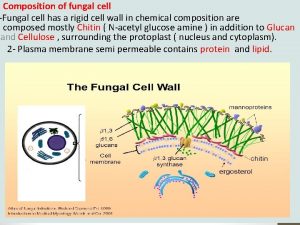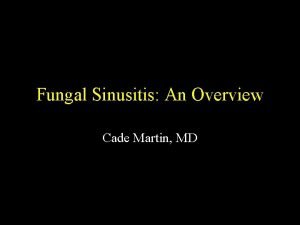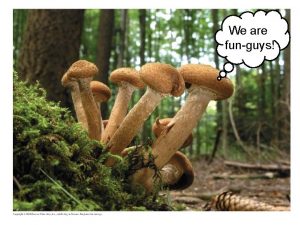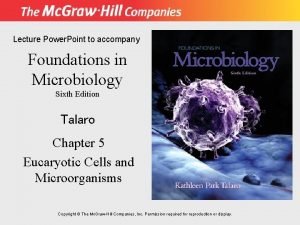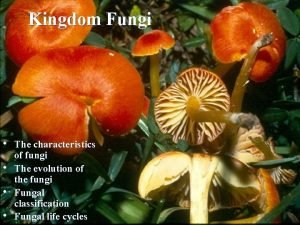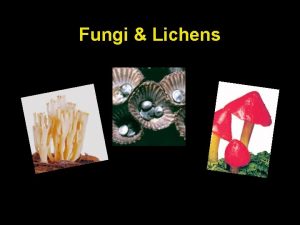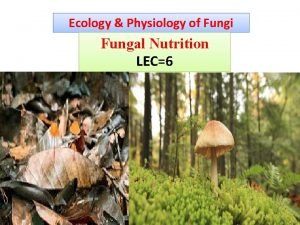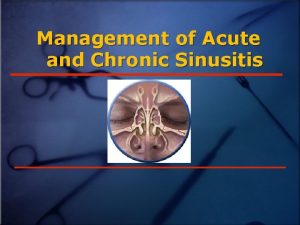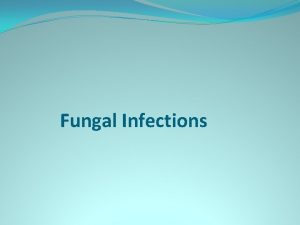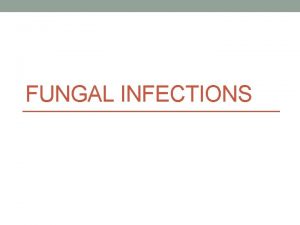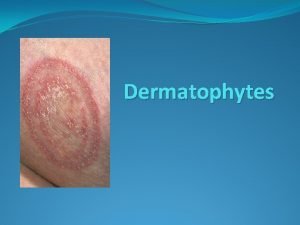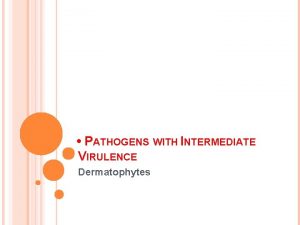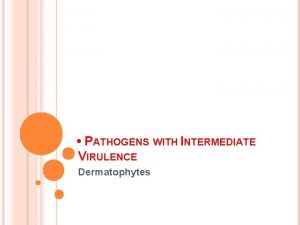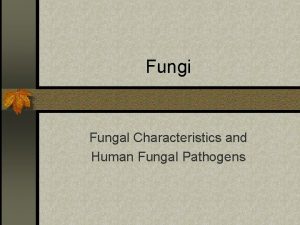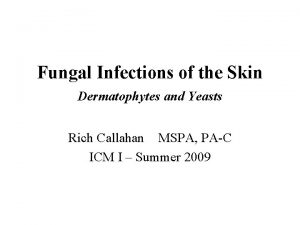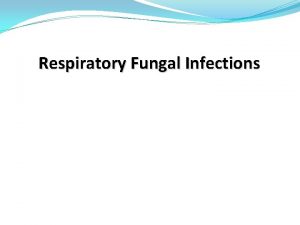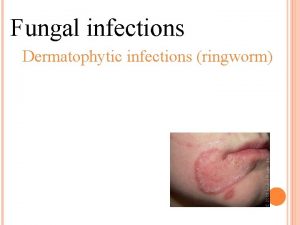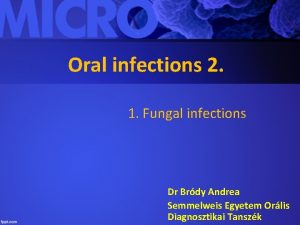General Characteristics of Fungal Infections Although the dermatophytes













- Slides: 13

General Characteristics of Fungal Infections

• Although the dermatophytes are known to be obligate parasites, most of the pathogenic fungi are living in the environment as saprophyte or have a close relation with both humans and animals commensally • Dermatofitlerin birkaçının obligat (zorunlu) parazitler olduğu düşünülse de patojenik mantarların çoğu çevrede saprofit olarak yaygındır ya da hayvan ve insanlarla ilişkili komensaller olarak bulunmaktadır. • Most of the fungi are opportunist pathogens and the factors that lead to developing of infections are: • Antibiotic usage in a long period. Thus the change in normal microbiata of host • Immunsupression • Simultaneıus infections • Mantarların çoğu fırsatçı patojenler olup mantar infeksiyonlarının şekillenmesinde rol oynayan predispoze edici faktörler: • Uzun süreli antibiyotik kullanımı sonucu konakçının normal mikrobiyotasının değişmesi • İmmunosupresyon • Eş zamanlı infeksiyonlar

• Skin and mucous membrane injuries or the loss of skin integrity • Deri ve muköz membranlarda yaralanmalar veya deri bütünlüğünün bozulması • Continous moist areas on skin • Deride sürekli nemli bölgelerin bulunması • Exposure to high infective dose of spores like «brooder pneumonia» observed in chicks caused by Aspegillus fumigatus • Ya da civcivlerde görülen “brooder pneumonia” da Aspergillus fumigatus sporlarında olduğu şekilde yüksek dozda infektif doza maruz kalmak • No epidemies are observed in fungal infections except «ringworm» that appear suddenly • Mantar hastalıkları «ringworm» enfeksiyonları dışında genellikle epidemiler şeklinde görülmez • In fungal infections there are no exo or endotoxins but in food of animals sometimes toxix metabolites can be developed by the fungi while developing on these food • Mantar infeksiyonlarında ekzotoksin ve endotoksin sentezlenmemektedir, ancak hayvan yemlerinde mantar üremesi sırasında daha önceden oluşan toksik metabolik ürünlere bağlı mikotoksikozisler şekillenebilmektedir.

1. Dermathophytes (Cutan Mycosis) 2. Systemic Miycosis 3. Other Fungi

Dermathophytes

1. • • • Cutan Mycosis Trichophyton Genus Microsporium Genus Epidermophyton Genus 2. Dermatophilosis

• Dermathophytes are close related fungi that uses keratin to reproduce • Dermatofitler üremek için keratini kullanan yakın ilişkili mantarlar bütünüdür. • They make infections on superficial regions like, stratum corneum, nails, hairs of both animals and humans • Derinin dış stratum corneum tabakası, tırnaklar, pençe ve insan ve hayvanların saç ve kılları gibi yüzeysel alanlarda infeksiyon oluştururlar. • Classical lesions are circular lesions called «Ringworm» • Klasik lezyonlar “Ringworm” olarak adlandırılan dairesel lezyonlardır. • Conventionally dermathophytes are classified as «Fungi Imperfecti» , nevertheless some of them are classified as Ascomycetes because of their known sexual reproduction • Geleneksel olarak dermatofitler “Fungi Imperfecti” sınıfında gösterilirken bazıları için seksüel aşama tespit edilmiş olup Ascomycetes grubunda sınıflandırılmıştır. • There are more than 38 dermathophyte species • 38’den fazla dermatofit türü bulunmaktadır. • The ones that effect animals are classified in the genus Microsporum and Trichophyton • Hayvanları etkileyenler Microsporum ya da Trichophyton genusunda yer almaktadır.

Frequent Dermathophyte Infections 1. Tinea capitis 2. Tinea pedis 3. Tinea corporis 4. Tinea cruris 5. Tinea barbea 6. Tinea ungium

Trichophyton Genus

• In animals, trichophytones lead to dermathomycoses particularly observed on skin, hair and nails • Trikofiton İnfeksiyonları (Trikofitozis), hayvanlarda, Trikofiton cinsine ait mantarlar tarafından özellikle deri, kıl ve tırnakların keratinize kısımlarında oluşan bir dermatomikozistir. • Some of them are zoonotic • Trikofiton cinsi çok geniş türe sahiptir ve bazıları zoonoz karakterlidir. • On solid agars the coloies can be cotton, granular, puffy, mucoid shaped and in different colour • Katı besiyerinde üreyen kolonileri kadife, pamuk, granüler, kabarık, mukoid görünümde ve çeşitli renklerde olabilmektedir. • The macroconidiums are oval, lemon, cigar or cylindirical and contains 2 -12 cells. They are rarely observed as a group • Makrokonidiumlar, oval, limon, puro ya da silindirik biçimlidir ve 2 -12 hücrelidir. Tek tek bulunurlar, nadiren gruplar halindedir. • The microconidiums are one cell, spherical or oval shaped. They can be found on hyphae one by one or as clusters • Mikrokonidiumlar, tek hücreli, yuvarlak, oval ya da armut biçimlidir. Hifa boyunca ya tek bulunurlar ya da kümeler halinde yer alırlar. • They do not give flourescence under the wood lamb light!!!! • Trikofitonlar, Wood Lambası altında fluoresans vermezler !

Trichophytones can be classied in two types according to the hair invasion 1) Ectothrix: The fungal arthropores can be found out of the hairs not inside • T. mentagrophytes • T. equinum • T. verrucosum • T. rubrum 2) Endothrix: The fungal arthropores can be found inside of the hair in parallel or irregularly • T. tonsurans • T. violaceum

Epidemiology • These kind of infections can be found all over the earth • Trikofiton’lardan ileri gelen dermatofitozislere dünyanın her yerinde sıkça rastlanmaktadır. • Trichophytosis can be spread directly by contact or indirectly between animals • Trikofitozis, direkt temas veya indirekt yollarla bir hayvandan diğer hayvana kolaylıkla bulaşır. • The infection is more contogious in especially in winter and in the crowded, dirty and moist barns • Özellikle kış aylarında kalabalık, pis ve rutubetli ahırlarda bulaşma daha çabuk şekillenir. • Mostly the young animals are effected • Genellikle genç hayvanlarda daha çok görülmektedir.

Important Pathogenic Species • • • Trichophyton Trichophyton Trichophyton equinum ( Horse, Dog ) rubrum ( Cow, Dog ) gallinae ( Chicken, Turkey, Dog ) soudanese ( Dog, Cat, Monkey ) megninii ( Horse, Cow, Dog ) violaceum ( Cow ) verrucosum ( Cow, Sheep, Horse, Dog ) concentricum ( Cow, Dog ) mentagrophytes ( Dog, Cat, Cow, Horse )
 Generalized fungal life cycle
Generalized fungal life cycle Kingdom fungi cell wall
Kingdom fungi cell wall Fungal cell wall
Fungal cell wall In what situation should a nail service be performed
In what situation should a nail service be performed Fungal uveitis
Fungal uveitis Black boogers
Black boogers Milady chapter 10 nail disorders and diseases
Milady chapter 10 nail disorders and diseases There's a fungus among us origin
There's a fungus among us origin Csf meningitis
Csf meningitis Fungal reproduction
Fungal reproduction Evolution of fungi
Evolution of fungi Threadlike fungi examples
Threadlike fungi examples Haustorium in fungi
Haustorium in fungi Allergic fungal sinusitis treatment
Allergic fungal sinusitis treatment
